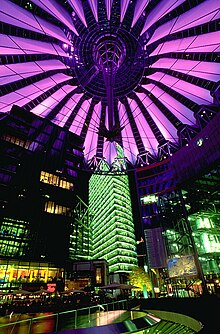Potsdamer Platz

Potsdamer Platz is an important square and traffic intersection in the center of Berlin, Germany, about 1 km south of the Brandenburg Gate (Brandenburger Tor) and the Reichstag (German Parliament Building). It is named after the city of Potsdam, some 25 km to the south west, and marks the point where the old road from Potsdam passed through the city wall of Berlin at the Potsdam Gate (Potsdamer Tor).
Pre-War
The heyday of Potsdamer Platz was in the 1920s and 1930s, by which period it had developed into one of the busiest traffic centers in all of Europe. Together with the Alexanderplatz, 2 km to the east, it was at the heart of Berlin's nightlife. Potsdamer Platz however represented the geographical centre of the city, the meeting place of five of its busiest streets in a star-shaped intersection deemed the transport hub of the continent. In the immediate area were hundreds of shops, hotels, restaurants, cinemas, theatres, dance-halls, cafes, bars, wine-houses and clubs, many of them internationally known. One of the world’s biggest and most luxurious department stores (Wertheim), was sited here, together with a huge multi-national-themed eating establishment (the Haus Vaterland), that could hold 8,000 people, and containing the world’s largest restaurant, which could seat 2,500 on its own. A major railway terminus (the Potsdamer Bahnhof), handling up to 80,000 passengers a day, was also close by, with Europe’s busiest interchange of surface and underground rail lines. 600 trams also passed through every hour, running on 40 different routes.
The world's first permanently-mounted electric street lights were installed here in 1882, and Europe's first traffic lights in 1924.
- See also 1920s Berlin.
World War II and Cold War
As was the case in most of Berlin, almost all of the buildings around Potsdamer Platz were turned to rubble by air raids and heavy artillery bombardment during the last years of World War II. Things were not helped by the close proximity of Adolf Hitler's enormous new Reich Chancellery building (just one block away), and many other Nazi government edifices nearby as well, and so Potsdamer Platz may have been a specific target.
When the city was divided into sectors by the occupying Allies at the end of the war, the square found itself on the boundary between the American, British, and Soviet sectors.
As Cold War tensions rose during the 1950s, restrictions were placed on travel between the Soviet sector (East Berlin) and the western sectors (West Berlin). Lying on this invisible frontier, Potsdamer Platz was no longer an important destination for Berliners.
With the construction of the Berlin Wall on August 13, 1961 along this intracity frontier, Potsdamer Platz found itself divided in two. What had once been a busy intersection had become desolate. With the clearance of ruined buildings on both sides (on the eastern side, chiefly to give border guards a clear view of would-be escapees and an uninterrupted line of fire), virtually nothing was left in an area of dozens of hectares.
After the Wall
After the fall of the Berlin Wall in November 1989, ex-Pink Floyd member Roger Waters staged a gigantic charity concert of his former band's rock extravaganza The Wall on July 21, 1990 to commemorate the end of the division between East and West Germany. The concert took place on the then-empty Potsdamer Platz and featured many guest superstars.
After 1990, the square became the focus of attention again, since it was an attractive location suddenly near the center of the city. The city government chose to divide the area into four parts, each to be sold to a commercial investor, which then planned new construction. During the building-phase the Potsdamer Platz was the largest building site in Europe.
The largest of these four parts went to Daimler-Benz, now part of Daimler-Chrysler, who charged Renzo Piano with creating a master plan for the new construction. The individual buildings were then built by many individual architects according to that plan. This includes the remarkable Potsdamer Platz No. 1 by Hans Kollhoff, now home to a number of prestigious law firms (in the photo on the right, the tall brick building in the center).

The second largest part went to Sony, which erected its new European headquarters there. This new Sony Center by Helmut Jahn, an impressive, yet light monolith of glass and steel (the rightmost building in the picture on the right), is considered by many to be one of the finest pieces of modern architecture in Berlin.
The whole project was the subject of much criticism from the beginning, and still not everyone applauds how the district was commercialized and replanned. However, the plaza now attracts about 70,000 visitors a day, and many critics are surprised by the success of the new quarter. At almost any time of the day, the place is packed with people. It has become a must-see for visitors, a top shopping area for Berliners, and probably the number-one spot to go for film fans, with more than 40 screens in three cinemas, a film academy and a film museum.
Some scenes of the 1987 Wim Wenders movie Der Himmel über Berlin (English title: Wings of Desire) are located on the old, almost entirely void Potsdamer Platz before the Wall fell. The movie thus gives a good impression of the surroundings at the time, which are completely unlike what can be seen today.
